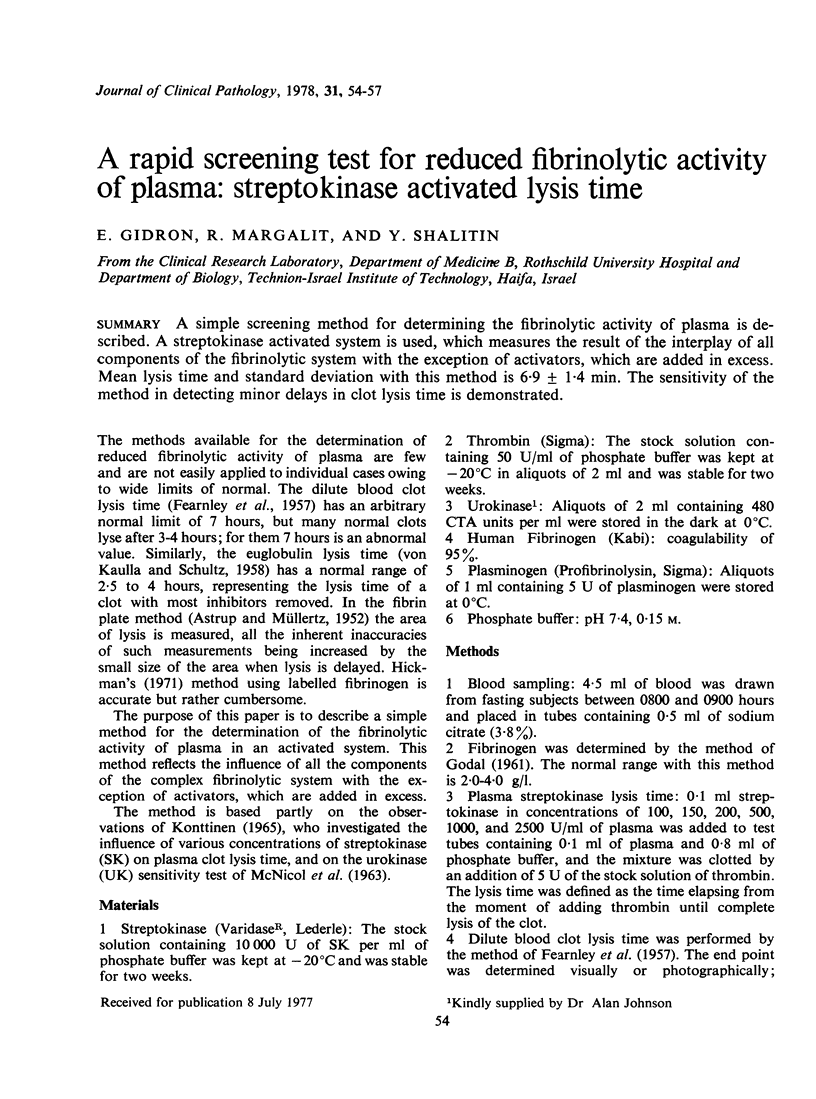Abstract
A simple screening method for determining the fibrinolytic activity of plasma is described. A streptokinase activated system is used, which measures the result of the interplay of all components of the fibrinolytic system with the exception of activators, which are added in excess. Mean lysis time and standard deviation with this method is 6.9 +/- 1.4 min. The sensitivity of the method in detecting minor delays in clot lysis time is demonstrated.
Full text
PDF



Selected References
These references are in PubMed. This may not be the complete list of references from this article.
- ASTRUP T., MULLERTZ S. The fibrin plate method for estimating fibrinolytic activity. Arch Biochem Biophys. 1952 Oct;40(2):346–351. doi: 10.1016/0003-9861(52)90121-5. [DOI] [PubMed] [Google Scholar]
- Angelin B., Einarsson K., Hellström K. Evidence for the absorption of bile acids in the proximal small intestine of normo- and hyperlipidaemic subjects. Gut. 1976 Jun;17(6):420–425. doi: 10.1136/gut.17.6.420. [DOI] [PMC free article] [PubMed] [Google Scholar]
- Barnes S., Gallo G. A., Trash D. B., Morris J. S. Diagnositic value of serum bile acid estimations in liver disease. J Clin Pathol. 1975 Jun;28(6):506–509. doi: 10.1136/jcp.28.6.506. [DOI] [PMC free article] [PubMed] [Google Scholar]
- Einarsson K., Hellström K., Kallner M. Bile acid kinetics in relation to sex, serum lipids, body weights, and gallbladder disease in patients with various types of hyperlipoproteinemia;. J Clin Invest. 1974 Dec;54(6):1301–1311. doi: 10.1172/JCI107876. [DOI] [PMC free article] [PubMed] [Google Scholar]
- FEARNLEY G. R., BALMFORTH G., FEARNLEY E. Evidence of a diurnal fibrinolytic rhythm; with a simple method of measuring natural fibrinolysis. Clin Sci. 1957 Nov;16(4):645–650. [PubMed] [Google Scholar]
- Fausa O., Gjone E. Serum bile acid concentrations in patients with liver disease. Scand J Gastroenterol. 1976;11(5):537–543. [PubMed] [Google Scholar]
- GODAL H. C. Simple syneresis procedure for fibrinogen assay. Scand J Clin Lab Invest. 1961;13:530–530. [PubMed] [Google Scholar]
- Gidron E., Margalit R., Oliven A., Shalitin Y. Effect of myocardial infarction on components of fibrinolytic system. Br Heart J. 1977 Jan;39(1):19–24. doi: 10.1136/hrt.39.1.19. [DOI] [PMC free article] [PubMed] [Google Scholar]
- Hickman J. A. A new technique for the quantitative estimation of fibrinolysis using in vitro (125-I)fibrinogen. Br J Haematol. 1971 Jun;20(6):611–621. doi: 10.1111/j.1365-2141.1971.tb00799.x. [DOI] [PubMed] [Google Scholar]
- Hofmann A. F. The enterohepatic circulation of bile acids in man. Clin Gastroenterol. 1977 Jan;6(1):3–24. [PubMed] [Google Scholar]
- Kaplowitz N., Kok E., Javitt N. B. Postprandial serum bile acid for the detection of hepatobiliary disease. JAMA. 1973 Jul 16;225(3):292–293. [PubMed] [Google Scholar]
- LaRusso N. F., Korman M. G., Hoffman N. E., Hofmann A. F. Dynamics of the enterohepatic circulation of bile acids. Postprandial serum concentrations of conjugates of cholic acid in health, cholecystectomized patients, and patients with bile acid malabsorption. N Engl J Med. 1974 Oct 3;291(14):689–692. doi: 10.1056/NEJM197410032911401. [DOI] [PubMed] [Google Scholar]
- MCNICOL G. P., GALE S. B., DOUGLAS A. S. In-vitro and in-vivo studies of a preparation of urokinase. Br Med J. 1963 Apr 6;1(5335):909–915. doi: 10.1136/bmj.1.5335.909. [DOI] [PMC free article] [PubMed] [Google Scholar]
- Makino I., Nakagawa S., Mashimo K. Conjugated and unconjugated serum bile acid levels n patients with hepatobiliary diseases. Gastroenterology. 1969 Jun;56(6):1033–1039. [PubMed] [Google Scholar]
- Margalit R., Gidron E., Shalitin Y. A new method for the determination of plasma activators fibrinolysis. Thromb Haemost. 1977 Apr 30;37(2):210–215. [PubMed] [Google Scholar]
- RUDMAN D., KENDALL F. E. Bile acid content of human serum. I. Serum bile acids in patients with hepatic disease. J Clin Invest. 1957 Apr;36(4):530–537. doi: 10.1172/JCI103450. [DOI] [PMC free article] [PubMed] [Google Scholar]
- Ross P. E., Pennington C. R., Bouchier I. A. Gas-liquid chromatographic assay of serum bile acids. Anal Biochem. 1977 Jun;80(2):458–465. doi: 10.1016/0003-2697(77)90668-6. [DOI] [PubMed] [Google Scholar]
- VON KAULLA K. N., SCHULTZ R. L. Methods for the evaluation of human fibrinolysis; studies with two combined technics. Am J Clin Pathol. 1958 Feb;29(2):104–112. doi: 10.1093/ajcp/29.2.104. [DOI] [PubMed] [Google Scholar]


